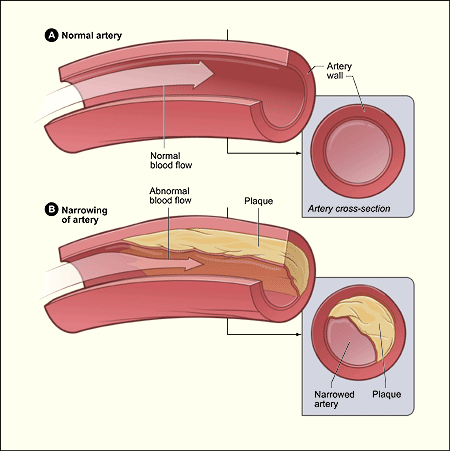atherosclerosis

Atherosclerosis, also known as hardening of the arteries, is a condition in which fatty material builds up along the walls of arteries. This fatty material thickens, hardens, and may eventually block the arteries.
Atherosclerosis is just one of several types of arteriosclerosis, which is characterized by thickening and hardening of artery walls, but the two terms are often used to mean the same thing. Diseases caused by atherosclerosis are the leading cause of illness and death in the United States and many other developed countries.
Causes and incidence
Atherosclerosis is a disorder of the arteries. It occurs when fat, cholesterol, and other substances build up in the walls of arteries and form hard substances called plaque.
Eventually, the plaque deposits can make the artery less flexible. This makes it harder for blood to flow. If blood flow in the arteries leading to the heart is reduced, chest pain can occur. Plaques can also break apart, causing pieces of material to move through the artery. This is a common cause of heart attack and stroke. Blood clots can also form around the plaque deposits. Clots block blood flow. If the clot moves into the heart, lungs, or brain, it can cause a stroke, heart attack, or pulmonary embolism.
Risk factors
Risk factors for atherosclerosis include:
Cerebrovascular disease, peripheral vascular disease, and kidney disease involving dialysis have also been linked to atherosclerosis.
Symptoms
Symptoms of atherosclerosis are usually not seen until blood flow becomes slowed or blocked. Typical symptoms of atherosclerosis include chest pain if an artery to the heart is involved. or leg pain when a leg artery is involved. Sometimes symptoms occur only with activity. In some people, however, they may occur at rest.
Signs and tests
A health care provider will perform a physical exam and listen to the heart and lungs with a stethoscope. Early atherosclerosis can create a whooshing or blowing sound ("bruit") over an artery. The pulse may be lower over arteries with atherosclerosis..
Tests that may be used to diagnose atherosclerosis (or complications) include:
Treatment
To some extent, the body will protect itself by forming new blood vessels around the affected area. This is called developing "collaterals."
A low-fat diet, weight loss, and exercise are usually suggested. Medications may be also recommended to reduce fats and cholesterol in your blood. Control of high blood pressure is also important.
Medications include cholestyramine, colestipol, nicotinic acid, gemfibrozil, atorvastatin, lovastatin, and others. Aspirin, ticlopidine, and clopidogrel (inhibitors of platelet clumping) or anti-coagulants may be used to reduce the risk of clot formation.
Balloon angioplasty uses a balloon-tipped catheter to flatten plaque and increase the blood flow past the deposits. The technique is used to open the arteries of the heart and other arteries in the body. Another widely used technique is stenting, which consists of implanting a small metal device inside the artery (usually following angioplasty) to keep the artery open.
Surgically removing deposits (endarterectomy) may be recommended in some cases. A bypass graft is the most invasive procedure. It uses a normal artery or vein from the patient to create a bridge that bypasses the blocked section of the artery.
Prognosis
The outcome varies. All people begin to develop some degree of atherosclerosis as they age, and in some people, it leads to complications. Heart attack and stroke are potentially fatal complications of atherosclerosis.
Complications
As plaque builds up, it can cause serious diseases and complications. These include:
Heart attack
Sudden death
Transient ischemic attack (TIA) or "mini strokes"


